
Dexter is a town in Penobscot County, Maine, United States. The population was 3,803 at the 2020 census. It is part of the Bangor metropolitan statistical area. Dexter Regional High School, which serves Dexter as well as other nearby small towns, is located in the town.
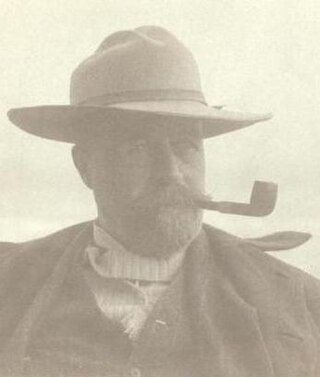
John Calvin Stevens was an American architect who worked in the Shingle Style, in which he was a major innovator, and the Colonial Revival style. He designed more than 1,000 buildings in the state of Maine.
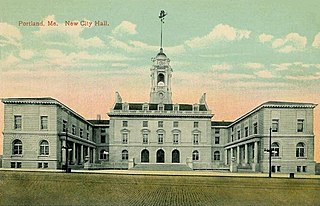
Portland City Hall is the center of city government in Portland, Maine. It is located at 389 Congress Street, and is set in a prominent rise, anchoring a cluster of civic buildings at the eastern end of Portland's downtown. The structure was built in 1909-12 and was listed on the National Register of Historic Places in 1973.

The Birches is a historic house on Foster Lane in Belgrade Lakes, Maine. Built in 1916 to a design by John Calvin Stevens and John Howard Stevens, it is the best-preserved surviving structure related to The Belgrade Hotel, a large summer resort hotel which burned down in 1955. It was listed on the National Register of Historic Places in 1996.

The House at 9 White Avenue in Wakefield, Massachusetts is a well-preserved transitional Queen Anne/Colonial Revival house. Built about 1903, it was listed on the National Register of Historic Places in 1989.
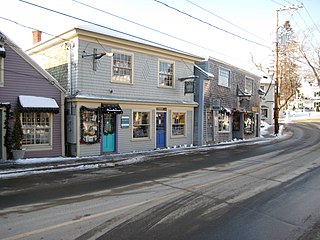
The Kennebunkport Historic District encompasses most of the village center of Kennebunkport, Maine. It includes the town's highest concentration of historic architecture, with many buildings from the late 18th and early 19th century, when Kennebunkport was at its height as a shipping and shipbuilding center. The district was added to the National Register of Historic Places on May 6, 1976.

The Staples Inn, now the Old Orchard Beach Inn, is an historic travelers' accommodation at 8 Portland Avenue in Old Orchard Beach, Maine. Located in a building dating to the late 18th century, it is the oldest known property to have regularly had summer boarders, with a documented history of doing so dating to 1840. The building was listed on the National Register of Historic Places in 1987.

Ralph Owen Brewster was an American politician from Maine. Brewster, a Republican, served as the 54th Governor of Maine from 1925 to 1929, in the U.S. House of Representatives from 1935 to 1941 and in the U.S. Senate from 1941 to 1952. Brewster was a close confidant of Joseph McCarthy of Wisconsin and an antagonist of Howard Hughes. He was defeated by Frederick G. Payne, whose campaign was heavily funded by Hughes, in the 1952 Republican primary.

Gordon Hall, also known as the Judge Samuel W. Dexter House, is a private house located at 8341 Island Lake Road in Dexter, Michigan. It was designated a Michigan State Historic Site in 1958 and listed on the National Register of Historic Places in 1972. The house is unique in Michigan for its balance, large scale, and massive hexastyle portico. The structure is also significant as the dwelling of Judge Samuel W. Dexter, a pioneering Michigan resident and land baron who had a substantial impact on early development of Washtenaw County and other sections of the state. The house was later owned by Dexter's granddaughter Katharine Dexter McCormick, a pioneering research scientist, suffragist, and philanthropist. In its early days, Gordon Hall hosted at least two, and possibly three United States presidents, and it was almost certainly a stop along the Underground Railroad.

Abbott Memorial Library is the public library of Dexter, Maine. It is located at 1 Church Street, in an architecturally sophisticated Renaissance Revival structure, built in 1894 as a gift from George Amos Abbott, a local mill owner. The building was listed on the National Register of Historic Places in 1978.
The John Peters House is a historic house, and the centerpiece of the John Peters Estate on Peters Point in Blue Hill, Maine. Built in 1815 and enlarged c. 1900 and 1920, the property is historically significant for its association with John Peters, one of the first proprietors of Blue Hill, who arrived in the region in 1765, and was a prominent figure in local political and economic life for many years. His house was listed on the National Register of Historic Places in 1983; after serving for a time in the 20th century as an inn, it is now available for rent as an event venue.
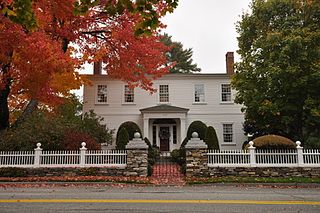
The Royal Brewster House is a historic house on Brewster Lane in the Buxton Lower Corner village of Buxton, Maine, United States. Built in 1805, it is an imposing Federal style house in a relatively rural setting. It was built for Dr. Royal Brewster, the town physician for about 40 years, and was the home for many years of Brewster's brother John, a well-known deaf-mute itinerant painter of folk portraiture. The house was listed on the National Register of Historic Places in 1975.
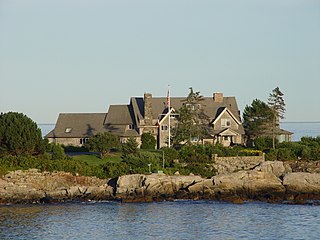
The Cape Arundel Summer Colony Historic District encompasses an enclave of large summer estates on the coast of Kennebunkport, Maine. The area was developed in the late 19th and early 20th century as a resort area for the wealthy of the northeastern United States. It notably includes the Kennebunk River Club and Walkers Point, the location of the Bush compound, which has a Shingle-style house built in 1903. The district was listed on the National Register of Historic Places in 1984.

The Isaac W. Dyer Estate is a historic property at 180 Fort Hill Road in Gorham, Maine. The property consists of an 1850s Greek Revival house, and a collection of farm-related outbuildings and landscaping added in the early 20th century as part of a transformation of the property into gentleman's farm by Isaac Watson Dyer, a prominent Portland lawyer. The property was listed on the National Register of Historic Places in 1998.

The Norton House Historic District encompasses two properties that formerly constituted the central portion of a suburban country estate in Falmouth, Maine. Located on Foreside Road, overlooking Casco Bay, the landscaped properties include a house and former carriage house designed by John Calvin Stevens and John Howard Stevens in 1912. The district was listed on the National Register of Historic Places in 2004.

The Capitol Complex Historic District encompasses the principal historic elements of Maine's state administration complex at Capitol and State Streets in Augusta, Maine. Included in the district are the Maine State House, Capitol Park, The Blaine House, the Burton Cross Office Building, and a number of state-owned 19th century residences in the vicinity of the Blaine House. The district was listed on the National Register of Historic Places in 2001.

The Huston House is a historic house at 220 Bristol Road in Damariscotta, Maine. Built in 1853, it is a rare statewide example of a large Greek Revival house with a longitudinal temple front. It now serves as home to the Down Easter Inn, and was listed on the National Register of Historic Places in 1985.
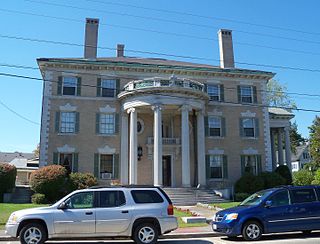
The Governor Hill Mansion is a historic house at 136 State Street in Augusta, Maine. It was built in 1901 for John F. Hill to a design by John Calvin Stevens, and is one of the state's grandest examples of Colonial Revival architecture. It now serves as an event facility. It was listed on the National Register of Historic Places in 1977.

Juniper Hill Farm, also known historically as Juniper Hill Inn and the Maxwell Evarts House, is a historic estate and mansion house on Juniper Hill Road in Windsor, Vermont. Built in 1902 by Maxwell Evarts, it is a large and elaborate example of Colonial Revival architecture. Evarts was a prominent New York lawyer, who played host to two presidents of the United States here. The property has seen a variety of commercial uses since the death of Evarts' son in 1936. In 2016, it reopened as the Windsor Mansion Inn with new owners. It was listed on the National Register of Historic Places in 1988.
William Edmund Brewster was an American banker, merchant, and politician from Maine. A bank president and longtime owner of a grocery store, Brewster also served three terms in the Maine House of Representatives. He was the father of United States Senator Ralph Owen Brewster



















